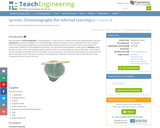
Students use chromatography to separate the components of ink.
- Subject:
- Engineering and Information Technologies
- Material Type:
- Lesson Plan
- Provider:
- TeachEngineering
- Provider Set:
- TeachEngineering
- Date Added:
- 10/14/2015

Students use chromatography to separate the components of ink.
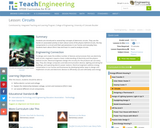
Students are introduced to several key concepts of electronic circuits. They learn about some of the physics behind circuits, the key components in a circuit and their pervasiveness in our homes and everyday lives. Students learn about Ohm's Law and how it is used to analyze circuits.
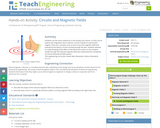
Students use the same method as in the activity from lesson 2 of this unit to explore the magnetism due to electric current instead of a permanent magnet. Students use a compass and circuit to trace the magnetic field lines induced by the electric current moving through the wire. Students develop an understanding of the effect of the electrical current on the compass needle through the induced magnetic field and understand the complexity of a three dimensional field system.

Students learn that ordinary citizens, including students like themselves, can make meaningful contributions to science through the concept of "citizen science." First, students learn some examples of ongoing citizen science projects that are common around the world, such as medical research, medication testing and donating idle computer time to perform scientific calculations. Then they explore Zooniverse, an interactive website that shows how research in areas from marine biology to astronomy leverage the power of the Internet to use the assistance of non-scientists to classify large amounts of data that is unclassifiable by machines for various reasons. To conclude, student groups act as engineering teams to brainstorm projects ideas for their own town that could benefit from community help, then design conceptual interactive websites that could organize and support the projects.
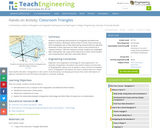
Students use bearing measurements to triangulate and determine objects' locations. Working in teams of two or three, they must put on their investigative hats as they take bearing measurements to specified landmarks in their classroom (or other rooms in the school) from a "mystery location." With the extension activity, students are challenged with creating their own maps of the classroom or other school location and comparing them with their classmates' efforts.
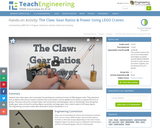
Students learn about gear ratios and power by operating toy mechanical cranes of differing gear ratios. They attempt to pick up objects with various masses to witness how much power must be applied to the system to oppose the force of gravity. They learn about the concept of gear ratio and practice calculating gear ratios on worksheets, discovering that smaller gear ratios are best for picking objects up quickly, and larger gear ratios make it easier to lift heavy objects.
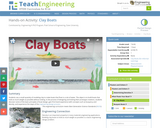
Students use a small quantity of modeling clay to make boats that float in a tub of water. The object is to build boats that hold as much weight as possible without sinking. In the process of designing and testing their prototype creations, students discover some of the basic principles of boat design, gain first-hand experience with concepts such as buoyancy and density, and experience the steps of the engineering design process.
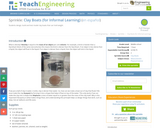
Students design, build and test model clay boats that can hold weight.
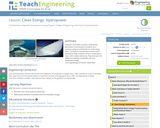
Hydropower generation is introduced to students as a common purpose and benefit of constructing dams. Through an introduction to kinetic and potential energy, students come to understand how a dam creates electricity. They also learn the difference between renewable and non-renewable energy.

Students are challenged to design a method for separating steel from aluminum based on magnetic properties as is frequently done in recycling operations. To complicate the challenge, the magnet used to separate the steel must be able to be switched off to allow for the recollection of the steel. Students must ultimately design, test, and present an effective electromagnet.
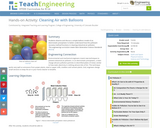
Students observe and discuss a simple balloon model of an electrostatic precipitator to better understand how this pollutant recovery method functions in cleaning industrial air pollution.
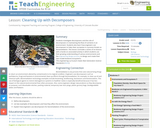
Students investigate decomposers and the role of decomposers in maintaining the flow of nutrients in an environment. Students also learn how engineers use decomposers to help clean up wastes in a process known as bioremediation. This lesson concludes a series of six lessons in which students use their growing understanding of various environments and the engineering design process, to design and create their own model biodome ecosystems.

Engineers design methods of removing particulate matter from industrial sources to minimize negative effects of air pollution. In this activity, students will undertake a similar engineering challenge as they design and build a filter to remove pepper from an air stream without blocking more than 50% of the air.
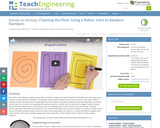
Posed with a paradigmatic engineering problem, students consider and explore mathematical algorithms and/or geometric concepts to devise possible solutions. The problem: How should a robotic vacuum move in order to best clean a floor of unknown shape and dimensions? They grapple with what could be a complex problem by brainstorming ideas, presenting the best idea for a solution and analyzing all presented solutions, and then are introduced to an elegant solution. Rather than elaborately calculating the most efficient route and keeping track of which tiles the robot has visited, a random number generator determines which direction the robot will take when it hits a barrier. Students are able to visually confirm how an unfamiliar programming concept (a random number generator) can make for a simple and efficient program that causes an NXT robot (that is suitably equipped) to clean a bare floor. Then students think of other uses for random numbers.
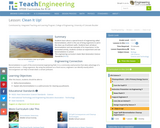
Students learn about a special branch of engineering called bioremediation, which is the use of living organisms to aid in the clean-up of pollutant spills. Students learn all about bioremediation and see examples of its importance. In the associated activity, students conduct an experiment and see bioremediation in action!
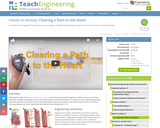
Following the steps of the engineering design process and acting as biomedical engineers, student teams use everyday materials to design and develop devices and approaches to unclog blood vessels. Through this open-ended design project, they learn about the circulatory system, biomedical engineering, and conditions that lead to heart attacks and strokes.

In this lesson, students continue their education on cells in the human body. They discuss stem cells and how engineers are involved in the research of stem cell behavior. They learn about possible applications of stem cell research and associated technologies, such as fluorescent dyes for tracking the replication of specific cells.
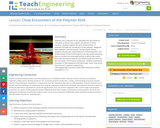
Polymers are a vital part of our everyday lives and nearly all consumer products have a plastic component of some variation. Students explore the basic characteristics of polymers through the introduction of two polymer categories: thermoplastics and thermosets. During teacher demos, students observe the unique behaviors of thermoplastics. The fundamentals of thermoset polymers are discussed, preparing them to conduct the associated activity in which they create their own thermoset materials and mechanically test them. At the conclusion of this lesson-activity pair, students understand the basics of thermoplastics and thermosets, which may entice their interest in polymer engineering.
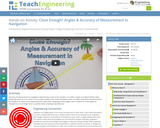
Accuracy of measurement in navigation depends very much on the situation. If a sailor's target is an island 200 km wide, sailing off center by 10 or 20 km is not a major problem. But, if the island were only 1 km wide, it would be missed if off just the smallest bit. Many of the measurements made while navigating involve angles, and a small error in the angle can translate to a much larger error in position when traveling long distances.

Students analyze international oil consumption and production data. They make several graphs to organize the data and draw conclusions about the overall use of oil in the world.